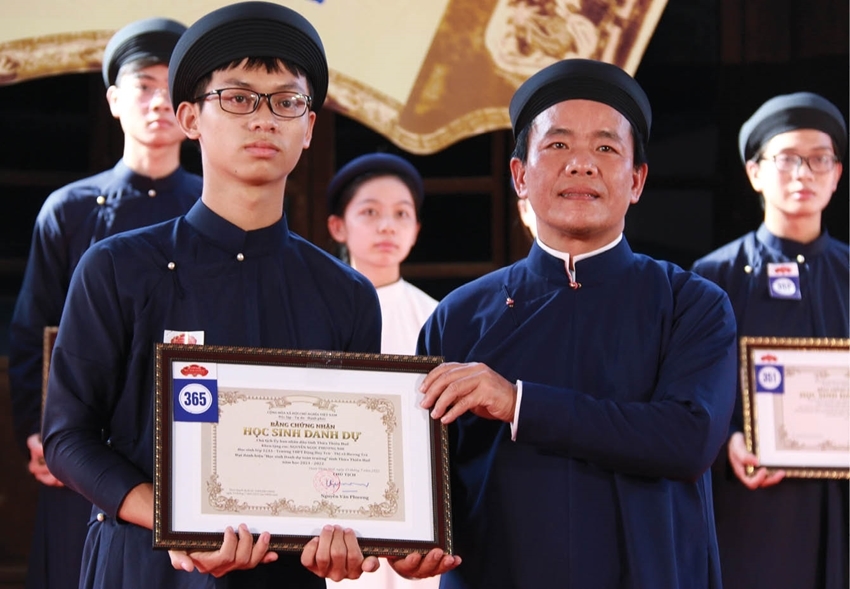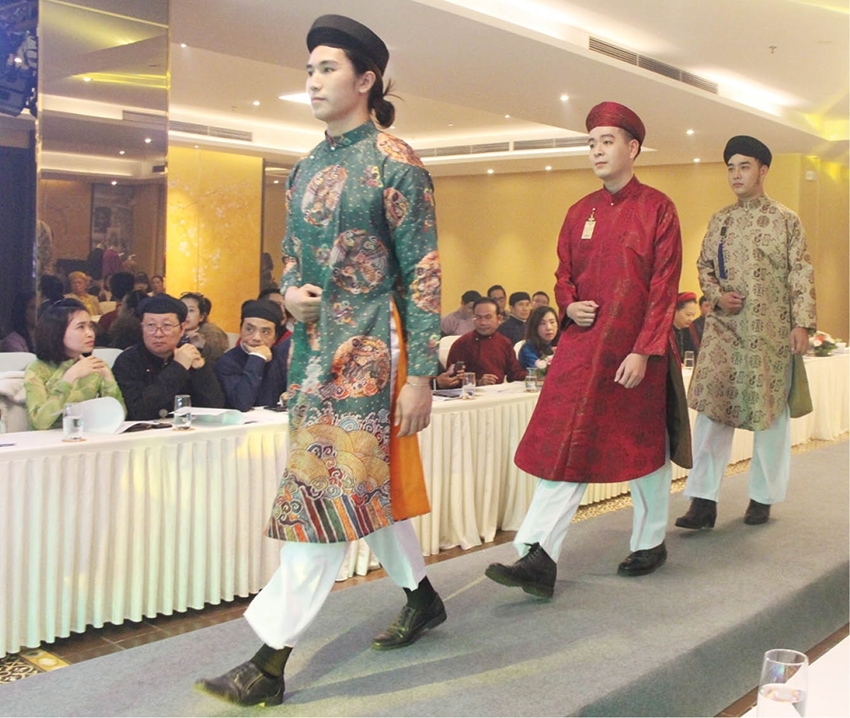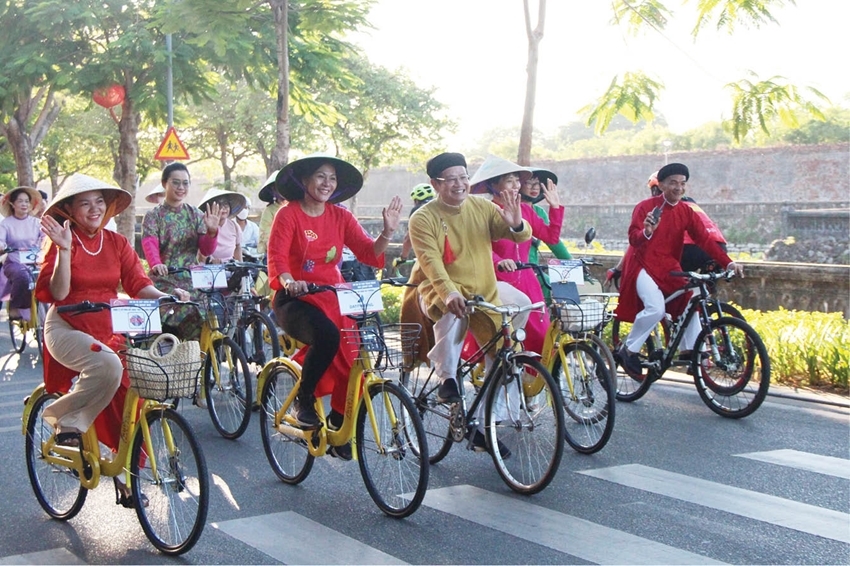 |
| Deputy Secretary of the City Party Committee and Chairman of the Hue City People’s Committee, Nguyen Van Phuong (on the right), wearing traditional Ao dai at an award ceremony for “Honorable students of the school” held at the Quoc Tu Giam space |
From the time Nguyen Hoang entered Thuan Hoa to when Nguyen Phuc Khoat ascended the throne, the separation between Dang Trong (Cochinchina) and Dang Ngoai (Tonkin) lasted over 180 years. The life of the people in Thuan Hoa continued to develop along the cyclical flow of Dai Viet culture, but it was also enriched by the alluvial deposits of Cham culture, with new and distinct creations different from the North. The clothing of the people also evolved accordingly.
Christoforo Borri, a missionary who came to Dang Trong between 1618 and 1622 (during the reign of Lord Nguyen Phuc Nguyen), described in his Italian travelogue - “An account of the new mission of the Jesuit priests in the Kingdom of Dang Trong”: “This region has the most modest attire for women in all of India... They wear five or six layers of undergarments in different colors... covered by a thin outer robe... creating an elegant and dignified appearance”. “Men’s clothing, on the other hand, consists of a cloth wrapped around the body instead of tight pants, with six layers of long, wide, colorful robes made of fine silk, with sleeves like those of the Benedictine Fathers.” “Students and teachers are solemn, not dressing flamboyantly, usually wearing a long black robe over other layers.” This description shows that the attire in Dang Trong had changed compared to Dang Ngoai, particularly with the black robes of scholars and teachers.
Phan Khoang, in his work “Vietnamese History: The Land of Dang Trong,” also noted that during the reign of Lord Nguyen Phuc Nguyen, Dao Duy Tu advised him to “request the people to change their customs to be completely different from those in the North, such as abandoning the flat palm hat and wearing the conical hat, replacing black pants with brown ones, abandoning, for women, the four-panel dress and wearing the five-panel dress with buttons, giving up the hair wrap for a large bun, and replacing skirts with pants.”
By the time of Lord Nguyen Phuc Khoat, along with organizing the court and transforming the lord’s residences and palaces into a capital, the five-panel Ao dai was perfected and mandated by the lord’s court as the representative attire, ordering the people of Dang Trong to adopt it. Through the brief upheavals of the Trinh occupation (1775-1786) and the Tay Son period (1786-1801), the attire in Dang Trong may have changed, but it fundamentally continued the style of the five-panel Ao dai from Lord Nguyen Phuc Khoat’s era.
 |
|
Hue is gradually affirming and spreading the unique value of the Ao dai
|
After returning to Phu Xuan, Emperor Gia Long wanted to standardize the national attire but hesitated, saying, “changing customs must be done gradually.” It was not until 1826 that Emperor Minh Mang ordered the scholars of Quang Binh to “adopt the clothing style of the scholars from the Gianh River southward.” In 1827, the emperor continued to issue an edict: “Now, the counties in the North of the Citadel should also promptly reform to achieve uniformity. However, changing customs is a new endeavor, and the people’s wealth varies..., it is necessary to allow ample time... By the spring of the 10th year of Minh Mang’s reign (1829), all must uniformly reform.”
However, nearly 10 years later (1837), the attire was still not unified, and the emperor had to issue a stern decree: “Previously, a special edict was issued to change to the clothing style from Quang Binh southward... with a generous deadline... Yet, some still clung to outdated customs... Therefore, it is mandated that within this year, all must uniformly change, and by the new year, if anyone still follows the old customs, they will be severely punished.” From then on, the Ao dai-Vietnam, born in the capital of Phu Xuan, became the national costume. From its cradle in Hue, the Ao dai became a cultural symbol of Vietnamese attire, uniquely original and distinct when standing alongside global fashion.
 |
| Hue Ao dai in a community activity |
For Hue, the Ao dai carries a glorious past and a unique style of the imperial capital. In other regions of the country, the Ao dai is often ceremonial attire, but in Hue, it serves both as formal wear and everyday clothing. There was a time when the Ao dai was always associated with the people of Hue. In the royal court, the emperor wore the Ao dai while reading and eating meals... Concubines and maids even slept in their Ao dai. Among the common people, teachers and students wore Ao dai while studying. Adults wore it when receiving guests. Everyone wore Ao dai while going to the market, selling goods, working in the fields, or rowing boats on the river...
Similar to the whole country, the men’s Ao dai has changed little in Hue, but the women’s one has changed over time. However, Hue women have persistently maintained their modesty, elegance, and dignity for their Ao dai. Through many changes, Hue female students still favor the dreamy purple Ao dai and the pure white Ao dai, as a way to affirm that they are Hue girls. Up to now, with countless variations of Ao dai, most Hue women still prefer styles filtered through time, which are both sexy but still modest, showing off the perfect beauty of the body’s curves.
Since the 1990s, along with the country’s innovation, Ao dai has revived with a new look. Especially from Hue, the Ao dai festivals, associated with Hue Festival and Hue Traditional Craft Festival from 2000 till now, have awakened the proud and elegant beauty of Ao dai. However, looking at it soberly, Ao dai has not revived in the daily lives of the people. It is worth noting that although Ao dai for women is popular, the Ao dai for men is only present in village and family affairs, mainly among the elderly. Hue’s youth only use Ao dai for weddings and on art stages. The image of Ao dai for men is still entangled with the past of an old time.
Recently, Hue has gradually affirmed that Hue Ao dai is an intellectual property with unique value in Hue’s cultural heritage, and determined to build the project “Hue – the Capital of Ao dai.” From many continuous efforts, on August 9, 2024, the Ministry of Culture, Sports and Tourism issued Decision No. 2320/QD-BVHTTDL announcing “Knowledge of sewing and wearing Hue Ao dai” as a National Intangible Cultural Heritage. Hue Ao dai was officially honored, affirming an important milestone in reviving Hue’s five-panel Ao dai. From this achievement, Hue is planning a dossier to propose the Central Government consider a submission to UNESCO for recognizing Ao dai Vietnam and Hue Ao dai as world cultural heritage.